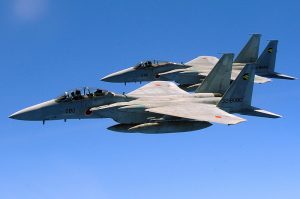The Japan Air Self-Defense Force (JASDF) scrambled its fighter aircraft a total of 778 times in fiscal year (FY) 2022 in response to foreign military aircraft approaching the country’s airspace. That marked a decrease of 23 percent compared with the same period in FY2021.
The Joint Staff Office (JSO) of the Ministry of Defense (MoD) said in an April 18 statement that there were 226 fewer scrambles in FY2022 compared to the previous fiscal year, with the figure representing the lowest number of scrambles since FY2020.
According to the data, JASDF fighters responded 575 times (74 percent of the total) to movements by Chinese military aircraft between April 1, 2022 and March 31, 2023; down 147 from the same period a year earlier. The JASDF recorded eight scrambles against China’s unmanned aerial vehicle (UAVs) in FY2022, doubling from four times in the previous fiscal year.
Japan also scrambled its fighters 150 times (19 percent of the total) in response to Russian military aircraft, down 116 from FY2021 and the lowest since FY2005.
“The Chinese and Russian militaries remain active around our country’s airspace,” Defense Minister Hamada Yasukazu said at a press conference on April 18, citing two joint long-distance flights by Chinese and Russian bombers around Japan, and the number of Chinese drone flights that significantly exceeded the previous year’s results.
According to the JSO, on May 24, the JASDF intercepted a joint flight made by four Xian H-6 Chinese strategic bombers and two Russian Tu-95 strategic bombers that overflew near the Japanese archipelago ‒ an apparent bid to warn against the Quad summit, held the same day, involving the leaders of Australia, India, Japan, and the United States.
In addition, on November 30, two Chinese H-6s and two Russian Tu-95s conducted a long-distance joint flight from the Sea of Japan to the East China Sea through the Pacific. Two Chinese aircraft, believed to be J-16 fighter jets, and two other suspected Chinese fighters later joined them on the same day.
The JSO also reported 53 scrambles against unidentified flying objects (UFOs) and other phenomena, more than quadruple the total of the previous year and the most since record-keeping began.
This is mainly because the JASDF has increased its scrambles responding to unidentified flying objects, following the discovery that a Chinese balloon was flying over the mainland United States this year. Washington alleges the balloon was meant for surveillance purposes, although Beijing denies this.
No violations of Japanese airspace were registered during FY 2022.
It is hard to say for sure that Russia’s invasion of Ukraine led to the significance decrease in Russian air activities in FY2022. For one thing, following Russia’s invasion of Crimea that started in February 2014, the number of intercepts of Russian aircraft by the JASDF actually increased by 32 percent in FY2014 from FY2013.
The Japanese government is reportedly considering using drones in JASDF scrambles to deal with foreign military aircraft approaching the country’s airspace. By doing so, it strives to prepare for a more assertive China and Russia, which use drones extensively.
The JASDF began its scramble operations in 1958, four years after the establishment of the Japan Self-Defense Forces. At first, such scrambles were primarily intended to respond to fighter aircraft from the former Soviet Union in the Cold War years.
In FY2012, when the Japanese government nationalized the Senkaku Islands – also claimed by China, which calls them the Diaoyu Islands – by purchasing three of the uninhabited islets in the East China Sea, the number of Chinese warplanes flying around Japan increased significantly. The number of scrambles against Chinese aircraft surpassed those against Russian aircraft for the first time in FY2012.
In FY2016, the JASDF scrambled its fighter aircraft a total of 1,168 times, the highest ever recorded in a year since such operations began in 1958. Scrambles against Chinese planes accounted for 73 percent of the total during FY2016.

































